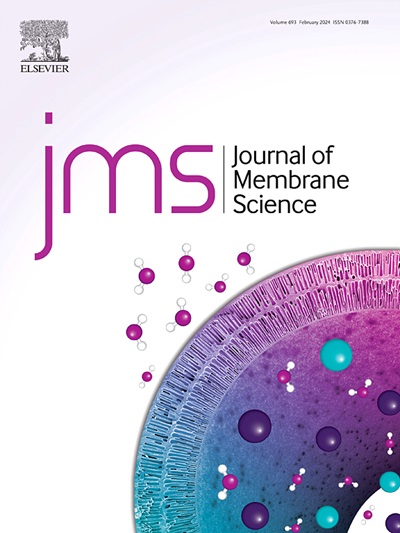Precise separation of flavor constituents from tobacco extracts via tailored nanofiltration membranes
IF 8.4
1区 工程技术
Q1 ENGINEERING, CHEMICAL
引用次数: 0
Abstract
Tobacco extract derived from tobacco leaves contains a broad range of bioactive compounds with significant industrial value, yet their structural diversity and overlapping molecular weights pose challenges for selective separation. In this work, a four-stage membrane cascade system, integrating ultrafiltration with three custom-designed nanofiltration (NF) membranes featuring precisely tuned molecular weight cut-offs (MWCOs), was developed to separate the targeted compounds from authentic tobacco extract. Results demonstrated that nicotine was gradually enriched with up to 97 % rejection, while flavor compounds ranging from 90 to 400 Da were selectively retained based on molecular sieving in the four-step membrane cascade system. Following filtration with a ∼342 Da MWCO membrane, the flavor compounds Rishitin (336 Da) and Butyl octyl phthalate (334 Da) were completely retained; subsequent filtration with a ∼180 Da MWCO membrane enabled 100 % retention of β-Violetol (194 Da) and Megastigmatrienone (190 Da); and flavor compounds with 90∼160 Da molecular weights were effectively retained using a ∼92 Da MWCO membrane at final stage. In contrast, low-molecular-weight (<90 Da) compounds exhibited lower retention due to their small size and weak membrane interactions. This membrane-based approach enables efficient and scalable purification of tobacco extract, offering new opportunities for clean processing and high-value utilization in the tobacco industry.

通过定制的纳滤膜精确分离烟草提取物中的风味成分
烟草提取液中含有多种具有重要工业价值的生物活性化合物,但其结构的多样性和分子质量的重叠给选择分离带来了挑战。在这项工作中,开发了一种四级膜级联系统,将超滤与三种定制的纳滤(NF)膜结合起来,这些纳滤膜具有精确调节的分子量切断(MWCOs),用于从正宗烟草提取物中分离目标化合物。结果表明,在四步膜级联系统中,尼古丁的富集率高达97%,而风味化合物在90 ~ 400 Da之间选择性保留。用~ 342 Da的MWCO膜过滤后,风味化合物石竹素(336 Da)和邻苯二甲酸丁辛酯(334 Da)被完全保留;随后用180da的MWCO膜过滤,使β-Violetol (194da)和Megastigmatrienone (190da) 100%保留;在最后阶段,使用~ 92 Da的MWCO膜有效地保留了分子量为90 ~ 160 Da的风味化合物。相比之下,低分子量(<90 Da)化合物由于其小尺寸和弱膜相互作用而表现出较低的保留。这种基于膜的方法能够有效和可扩展地纯化烟草提取物,为烟草工业的清洁加工和高价值利用提供了新的机会。
本文章由计算机程序翻译,如有差异,请以英文原文为准。
求助全文
约1分钟内获得全文
求助全文
来源期刊

Journal of Membrane Science
工程技术-高分子科学
CiteScore
17.10
自引率
17.90%
发文量
1031
审稿时长
2.5 months
期刊介绍:
The Journal of Membrane Science is a publication that focuses on membrane systems and is aimed at academic and industrial chemists, chemical engineers, materials scientists, and membranologists. It publishes original research and reviews on various aspects of membrane transport, membrane formation/structure, fouling, module/process design, and processes/applications. The journal primarily focuses on the structure, function, and performance of non-biological membranes but also includes papers that relate to biological membranes. The Journal of Membrane Science publishes Full Text Papers, State-of-the-Art Reviews, Letters to the Editor, and Perspectives.
 求助内容:
求助内容: 应助结果提醒方式:
应助结果提醒方式:


